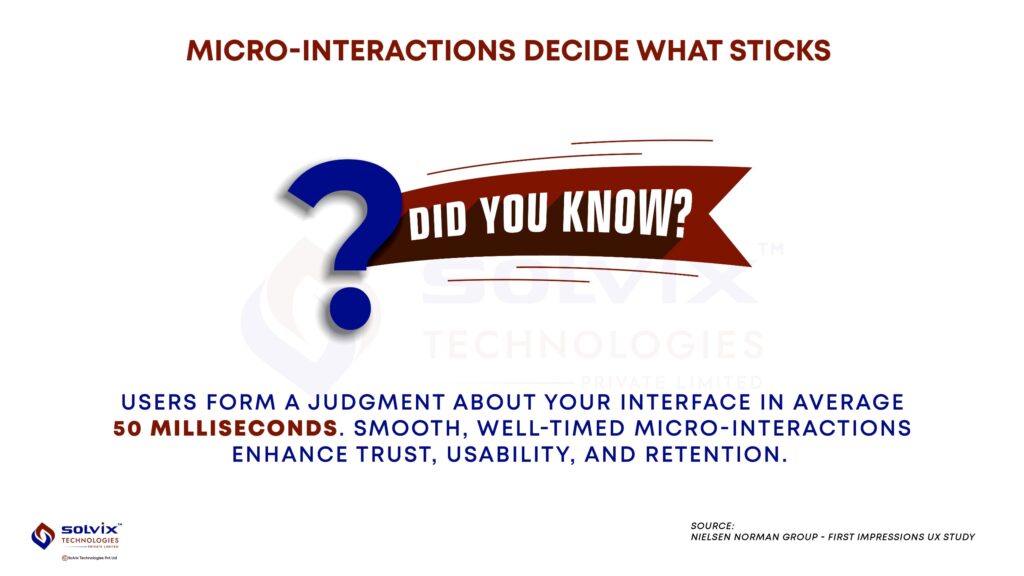No products in the cart.
How Micro Interaction in UI Design Changes the Game
Micro-interactions are not visual flourishes or ornamental animations—they are design’s response to human behavior. When a user performs an action and the interface responds with a subtle cue—a swipe sound, a toggle animation, a password strength bar—that’s a micro-interaction in motion.
A well-crafted micro-interaction shapes user experience with silent efficiency. It doesn’t boast, but it makes the interface feel alive, responsive, and human. Any ui ux design agency that understands the science of attention and emotion places micro-interactions at the core of their interface logic.
Deconstructing Micro-Interactions: The Four-Part Model
Dan Saffer, a prominent voice in interaction design, defines micro-interactions through a four-step framework:
- Trigger – An action initiated by the user (e.g., clicking a “like” button) or the system (e.g., a ping when a file download finishes).
- Rules – The logic that dictates what follows after the trigger.
- Feedback – How the system communicates that something is happening, often visually or through haptics.
- Loops & Modes – These handle what happens over time or under different conditions (like how a notification badge behaves when you don’t check it for days).
Saffer’s framework isn’t theoretical—it underpins every successful modern interface. Whether in mobile ui ux design services or desktop platforms, the most engaging digital products are built on these principles.
Why Micro-Interactions Matter (More Than You Think)

Research from the Nielsen Norman Group confirms that users form first impressions in as little as 50 milliseconds. The smoother the interaction, the better the trust. Micro-interactions are the invisible thread that tightens this bond.
1. Enhances Functionality Through Subtlety
A simple hover effect can reveal options without cluttering the interface. Think of a dropdown menu animating just enough to guide attention. These micro-events clarify intent without overwhelming the user.
2. Reduces Cognitive Load
UX is not only about beauty—it’s about clarity. A loading spinner, a swipe-to-delete animation, a progress bar in form submission—each tells the user: “We hear you, we’re on it.”
3. Boosts Emotional Engagement
A toggle that flips with a bounce. A heart icon that bursts with color when tapped. These small delights create stickiness. According to a study published by the Interaction Design Foundation, delightful feedback loops significantly increase user retention in app interfaces.
4. Signals System Status Transparently
Users hate ambiguity. Micro-interactions like visual cues for errors, success, and loading give users a sense of control. When these are ignored, users disengage. When implemented right, they return.
Where You See Micro-Interactions Daily
- Swipe animations in email apps for delete/archive.
- Lottie animations that confirm a successful task.
- Real-time typing indicators in messaging platforms.
- Password strength checkers with color and motion cues.
Platforms that utilize figma ui ux design workflows can prototype these behaviors early, ensuring consistency and clarity from concept to launch.
How UI/UX Professionals Handle Micro-Interactions
For an experienced ui ux design agency, micro-interactions are not afterthoughts. They are part of the design system from the beginning. Teams begin mapping interaction flows during early wireframing. Tools like Figma, Framer, and Protopie allow designers to simulate real-time feedback loops during testing phases.
What sets elite ui ux design services apart is not just aesthetic sense—it’s attention to detail in motion, transition, and user anticipation. These designers study human psychology, motion curves, and device behaviors to design micro-interactions that don’t just look good—they feel right.
Key Principles for Designing Micro-Interactions
- Purpose-First Motion
Animation must serve clarity, not just style. Avoid delays or overuse.
- Consistent Feedback Language
A color or motion that means “success” should be used consistently across the platform.
- Real-Device Testing
Especially in mobile ui ux design services, designers must test micro-interactions on actual devices, not just simulators.
- Keep It Lightweight
Users don’t have patience for performance lag. If your micro-interaction costs speed, it fails the test.
Conclusion
Micro-interactions are the smallest units of user experience—but their impact is disproportionately large. They define how a product feels. And in a digital world where first impressions decide product success, feel is everything.
When integrated thoughtfully by a skilled ui ux design agency, they do more than guide the user—they build emotional connections. In environments driven by figma ui ux design, these connections are mapped, tested, and refined with precision.
For companies offering ui ux design services, understanding micro-interactions isn’t optional—it’s essential. They’re the difference between an interface that’s tolerated and one that’s loved.
